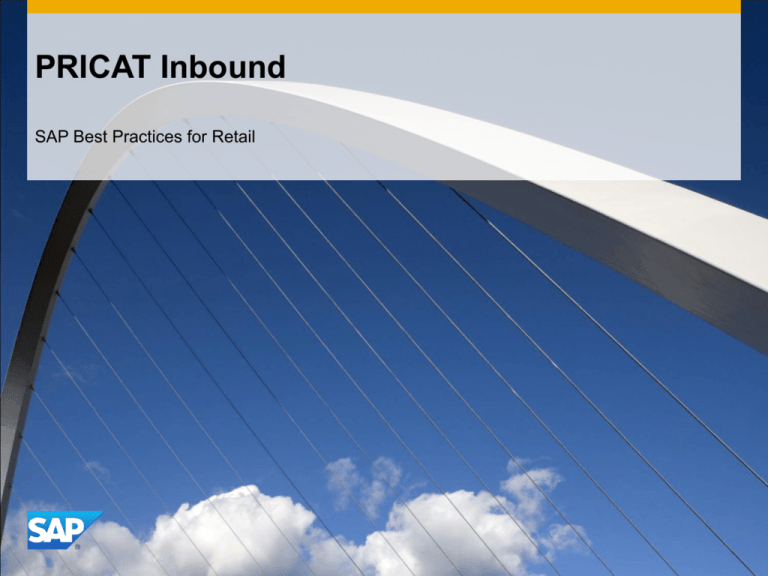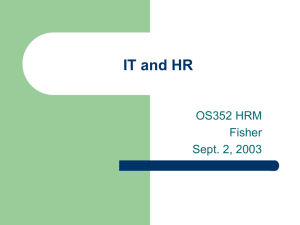
PRICAT Inbound
SAP Best Practices for Retail
Purpose, Benefits, and Key Process Steps
Purpose
In this scenario you transfer pricing and catalog-related data for goods and services from a
vendor to a buyer.
Benefits
Efficient merchandise control which fulfills the requirements of ECR-compliant procurement
processes
Simulation of data coming from the manufacturer and process this data further in the
retailer system
Key Process Steps
Simulation of PRICECATALOGUE IDoc inbound processing
Inbound Processing of a Price catalog
Processing of Catalog Items manually / automatically
Creating / Changing of articles
© 2011 SAP AG. All rights reserved.
2
Required SAP Applications and Company Roles
Required SAP Applications
SAP SAP enhancement package 3 for SAP ERP 6.0
Company Roles
Retail Master Data Manager
Manufacturer
© 2011 SAP AG. All rights reserved.
3
Process Flow Diagram
Manufacturer
PRICAT Inbound
Create Pricecatalog IDoc
Retail Master Data Manager
Simulated
Checking / Changing
Catalog Items
Inbound Processing
© 2011 SAP AG. All rights reserved.
Posting a Pricat Item
Create / Change
Articles
Selecting a Catalog
Automatic
Processing
4
PRICAT Inbound
Introduction
Between Retailers and Manufacturer of the German textile and
apparel industry, cooperatively concepts within the framework of
procurement, marketing and using of information and communication
technology are developed.
Collaboration concepts, like Efficient Consumer Response (ECR),
earn on importance. The new technologies open small and middle
comanies the possibility to accomplish the structure change and also
to reinforce their competitive strength.
SAP offers a software solution within the framework of the SAP Best
Practices Version, which reflects the new requirements of ECR
conformable procurement processes.
© 2011 SAP AG. All rights reserved.
5
PRICAT Inbound
Introduction
With SAP software you have the possibility to build up the
manufacturer and also the retailer side.
The ECR conformable procurement processes embrace the price
catalog, the buyer managed inventory, and also the vendor managed
inventory.
© 2011 SAP AG. All rights reserved.
6
Price Catalog: PRICAT
Is an EANCOM standard message type
Area of master data
Enables pricing and catalog-related data for goods and services to be
transferred from a vendor to a buyer
Complete listing of all products
Notification of changes
Information relevant for all customers
Customer-specific information
Data supplied to a central article database
© 2011 SAP AG. All rights reserved.
7
Price catalog: Supply of a data pool
Vendor
Retailer
Sender
Recipient
Data Pool
f. e. Sinfos
Generate of
PriceCatalogue Idocs
XI
Master Data
XI
Inbound processing
of PriceCatalogue Idoc
BAPI/ALE
© 2011 SAP AG. All rights reserved.
8
Price catalog inbound: process flow
Simulation of IDoc
Inbound processing
Display Header Data
(catalog)
List of article
Adopt Profile
Process Price catalog
manual / automatical
Process not existing article data in the
Customer system (EAN‘s) /
Creating article
© 2011 SAP AG. All rights reserved.
Process available article data in the
customer system (EAN‘s) /
Update of article
9
Price Catalog Inbound: Catalog Creation
The catalog is stored on the database as a separate business
object PriceCatalog
EANCOM fields that do not correspond to R/3 fields are transferred to
the system
It is possible to select articles to be updated
Transfer can be controlled at field level
If an EAN exists uniquely in the system, article assignment is
carried out
If errors occur, an application log containing all messages is
created (transaction PRICATLOG)
© 2011 SAP AG. All rights reserved.
10
Price Catalog Inbound: Preparation
lPreparation
before catalog transfer
Assignment of ILN to SAP vendor, purchasing group
Assignment of merchandise categories to SAP merchandise categories (for
each ILN)
Assignment of SAP merchandise categories to purchasing groups
lWorkflow
preparation
Assignment of buyers (SAP users) to organizational units, to which the
relevant purchasing groups are assigned (transaction PFOM)
© 2011 SAP AG. All rights reserved.
11
Price Catalog Inbound: Accessing Catalog Maintenance
Header data
Set
catalog status
After processing, the catalog status is automatically set to 'processed'
Catalog status can be manually set to 'closed‚
Set
test indicator
If you want to process the catalog, you have to always enter the purchasing group
Price catalog could be processed manually or automatically
© 2011 SAP AG. All rights reserved.
12
Price Catalog Inbound: Accessing Catalog Maintenance
List of articles
In the list of articles, you will find the article (items) of the new
price catalog
Items are distributed among several views according to their
status
New items have no entry in the field “article” and you can find this
items in the “to be processed” tab and “all entries”
© 2011 SAP AG. All rights reserved.
13
Price Catalog Inbound: Assignment of EAN to an Article
The assignment of EAN to an article occurs automatically when a catalog
is created (unique EAN)
lManually in catalog maintenance
Assigned article is stored in price catalog
Can be entered at a later date
If the EAN is not unique, all possible EANs are displayed
For assignment, articles are also displayed with the vendor article number
from the catalog
New articles need template articles (proposed from the merchandise
category)
© 2011 SAP AG. All rights reserved.
14
Price Catalog Inbound: Transferring Catalog Data to
Article Data
Adopt Profile
The transfer of catalog data to article data could be done with an adopt profile
The adopt profile enables the simultaneous display of catalog data and article data
(or in the case of new data, the template article)
Required data must be explicitly transferred from the catalog to the article side, either
manually or by using a transfer profile
Adopt profiles could be stored and used again
The article fields can be edited
© 2011 SAP AG. All rights reserved.
15
Price Catalog Inbound: Assignment of EAN to Unit of
Measure
lAutomatically
By mapping the EANCOM packaging type to alternative unit of measure in
the converter
During R/3-R/3 data interchange
lManually
lNew
in catalog maintenance
Can be changed at a later date
units of measure must be explicitly transferred
It is possible to transfer all units of measure from the catalog
© 2011 SAP AG. All rights reserved.
16
© 2011 SAP AG. All rights reserved
No part of this publication may be reproduced or transmitted in any form or for any purpose
without the express permission of SAP AG. The information contained herein may be
changed without prior notice.
Some software products marketed by SAP AG and its distributors contain proprietary
software components of other software vendors.
Microsoft, Windows, Excel, Outlook, and PowerPoint are registered trademarks of Microsoft
Corporation.
IBM, DB2, DB2 Universal Database, System i, System i5, System p, System p5, System x,
System z, System z10, System z9, z10, z9, iSeries, pSeries, xSeries, zSeries, eServer,
z/VM, z/OS, i5/OS, S/390, OS/390, OS/400, AS/400, S/390 Parallel Enterprise Server,
PowerVM, Power Architecture, POWER6+, POWER6, POWER5+, POWER5, POWER,
OpenPower, PowerPC, BatchPipes, BladeCenter, System Storage, GPFS, HACMP,
RETAIN, DB2 Connect, RACF, Redbooks, OS/2, Parallel Sysplex, MVS/ESA, AIX,
Intelligent Miner, WebSphere, Netfinity, Tivoli and Informix are trademarks or registered
trademarks of IBM Corporation.
Linux is the registered trademark of Linus Torvalds in the U.S. and other countries.
Adobe, the Adobe logo, Acrobat, PostScript, and Reader are either trademarks or
registered trademarks of Adobe Systems Incorporated in the United States and/or other
countries.
Oracle is a registered trademark of Oracle Corporation.
UNIX, X/Open, OSF/1, and Motif are registered trademarks of the Open Group.
Citrix, ICA, Program Neighborhood, MetaFrame, WinFrame, VideoFrame, and MultiWin are
trademarks or registered trademarks of Citrix Systems, Inc.
HTML, XML, XHTML and W3C are trademarks or registered trademarks of W3C®, World
Wide Web Consortium, Massachusetts Institute of Technology.
Java is a registered trademark of Sun Microsystems, Inc.
JavaScript is a registered trademark of Sun Microsystems, Inc., used under license for
technology invented and implemented by Netscape.
Business Objects and the Business Objects logo, BusinessObjects, Crystal Reports, Crystal
Decisions, Web Intelligence, Xcelsius, and other Business Objects products and services
mentioned herein as well as their respective logos are trademarks or registered trademarks
of Business Objects Software Ltd. Business Objects is an SAP company.
Sybase and Adaptive Server, iAnywhere, Sybase 365, SQL Anywhere, and other Sybase
products and services mentioned herein as well as their respective logos are trademarks or
registered trademarks of Sybase, Inc. Sybase is an SAP company.
All other product and service names mentioned are the trademarks of their respective
companies. Data contained in this document serves informational purposes only. National
product specifications may vary.
The information in this document is proprietary to SAP. No part of this document may be
reproduced, copied, or transmitted in any form or for any purpose without the express prior
written permission of SAP AG.
This document is a preliminary version and not subject to your license agreement or any
other agreement with SAP. This document contains only intended strategies, developments,
and functionalities of the SAP® product and is not intended to be binding upon SAP to any
particular course of business, product strategy, and/or development. Please note that this
document is subject to change and may be changed by SAP at any time without notice.
SAP assumes no responsibility for errors or omissions in this document. SAP does not
warrant the accuracy or completeness of the information, text, graphics, links, or other items
contained within this material. This document is provided without a warranty of any kind,
either express or implied, including but not limited to the implied warranties of
merchantability, fitness for a particular purpose, or non-infringement.
SAP shall have no liability for damages of any kind including without limitation direct,
special, indirect, or consequential damages that may result from the use of these materials.
This limitation shall not apply in cases of intent or gross negligence.
The statutory liability for personal injury and defective products is not affected. SAP has no
control over the information that you may access through the use of hot links contained in
these materials and does not endorse your use of third-party Web pages nor provide any
warranty whatsoever relating to third-party Web pages.
SAP, R/3, SAP NetWeaver, Duet, PartnerEdge, ByDesign, SAP BusinessObjects Explorer,
StreamWork, and other SAP products and services mentioned herein as well as their
respective logos are trademarks or registered trademarks of SAP AG in Germany and other
countries.
© 2011 SAP AG. All rights reserved.
17







